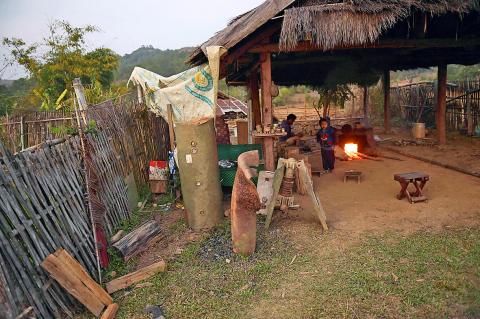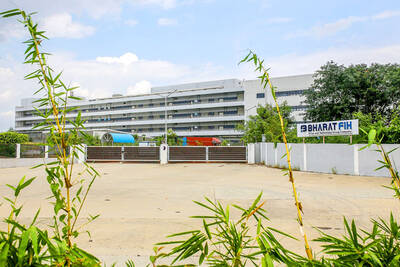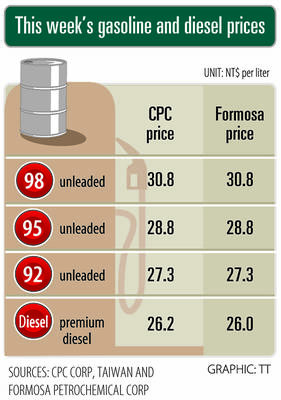Forty years after the end of the Vietnam war, US bombs dropped along the Ho Chi Minh Trail in Laos have become expensive jewelry worn by US fashionistas.
Delicate bracelets encrusted with diamonds, bronze pendants, necklaces and drop earrings — all made from ordnance left over from the US’ deadliest war — are on display on the sidelines of New York Fashion Week.
Crafted by artisans in Laos, who smelted shrapnel in straw-roofed workshops, they are distributed by Brooklyn startup Article 22 and now sold in nearly 40 countries.

Photo: AFP
Inscriptions such as “love is the bomb” and “dropped + made in Laos” are engraved into the metal, a play on modern slang in which “bomb” means “cool,” not just a lethal weapon of war.
“We want the jewelry to be conversational pieces,” said Elizabeth Suda, cofounder of Article 22, which is named after the universal declaration of human rights.
“When you see someone wearing a bomb, you’re gonna ask, what’s it all about? Why? In a very literal way, it tells a story,” she said.
Article 22 calls its jewelry line “Peacebomb” and in a sign of its growing stature, items have been selected to appear in a stall operated by trendy fashion-forward boutique The Curve on the sidelines of Fashion Week.
However, not only has the jewelry been endorsed by US actresses Zoe Kravitz and Olivia Wilde — it also prides itself on being ethical.
Since being set up in 2010, Article 22 says it has paid to demine 65,000m2 of land in Laos, the most bombed country per capita on the planet.
Profits from the simplest bracelet clears 3m2, while their most expensive piece, a US$1,250 necklace, clears up to 78m2.
“The problem of unexploded bombs could harm the health and opportunities of Lao people for generations to come, if not for efforts like Article 22,” said Channapha Khamvongsa from the Legacies of War advocacy group.
Many of the tens of millions of bombs dropped from 1964 to 1973 never exploded, leaving behind about 80 million tennis-sized bomblets that have killed thousands of villagers and children.
In the highlands of Xieng Khuang Province, artisans in the village of Ban Naphia smelted ordnance fragments into a thick, shiny liquid that they first fashioned into spoons.
“They were able to take something so negative and turn it into something that was positive and useful and that could generate income,” Suda said. “It was really a way of them reclaiming their land and their place in the world.”
Discovering their work, she came up with the idea of making bracelets for export, promising to buy the first 500 for four times the local price, and thus her initiative, Buy Back the Bombs, was born.
Over the intervening years, they have refined and diversified their designs into a full collection of bangles, necklaces and pendants.
Jewelry made from Ban Naphia bombs now sell in 39 different countries through 150 different retailers.
“People really like those a lot because they are unique pieces that they can’t find anywhere and it allows them to become story tellers also,” said Suda’s business partner, former banker Camille Hautefort.
Nevena Borissova, founder of The Curve chain of high-fashion boutiques in New York and other US cities, was happy to showcase their work.
She praised the “amazing” jewelry.
“They make money, they employ and support the local communities. I was like, we’re behind it,” she said.
Sass Brown, acting associate dean of the Fashion Institute of Technology’s School of Art and Design in New York, said Article 22 is part of a trend for similar projects.
Falling Whistles sells whistles fashioned after those used by child soldiers to raise money for war victims in the Democratic Republic of Congo.
Emi and Eve sells jewelry and metal clutch bags out of recycled bomb casings and bullet shells from Cambodia, and Fonderie 47 makes watches and jewelry from AK47s from Africa.
Brown said the best fashion is subversive.
“I think the best fashion makes people think and does challenge people. That’s the role of art, in its purest form,” she said.

SETBACK: Apple’s India iPhone push has been disrupted after Foxconn recalled hundreds of Chinese engineers, amid Beijing’s attempts to curb tech transfers Apple Inc assembly partner Hon Hai Precision Industry Co (鴻海精密), also known internationally as Foxconn Technology Group (富士康科技集團), has recalled about 300 Chinese engineers from a factory in India, the latest setback for the iPhone maker’s push to rapidly expand in the country. The extraction of Chinese workers from the factory of Yuzhan Technology (India) Private Ltd, a Hon Hai component unit, in southern Tamil Nadu state, is the second such move in a few months. The company has started flying in Taiwanese engineers to replace staff leaving, people familiar with the matter said, asking not to be named, as the

The prices of gasoline and diesel at domestic fuel stations are to rise NT$0.1 and NT$0.4 per liter this week respectively, after international crude oil prices rose last week, CPC Corp, Taiwan (台灣中油) and Formosa Petrochemical Corp (台塑石化) announced yesterday. Effective today, gasoline prices at CPC and Formosa stations are to rise to NT$27.3, NT$28.8 and NT$30.8 per liter for 92, 95 and 98-octane unleaded gasoline respectively, the companies said in separate statements. The price of premium diesel is to rise to NT$26.2 per liter at CPC stations and NT$26 at Formosa pumps, they said. The announcements came after international crude oil prices

STABLE DEMAND: Delta supplies US clients in the aerospace, defense and machinery segments, and expects second-half sales to be similar to the first half Delta Electronics Inc (台達電) expects its US automation business to remain steady in the second half, with no signs of weakening client demand. With demand from US clients remaining solid, its performance in the second half is expected to be similar to that of the first half, Andy Liu (劉佳容), general manager of the company’s industrial automation business group, said on the sidelines of the Taiwan Automation Intelligence and Robot Show in Taipei on Wednesday. The company earlier reported that revenue from its automation business grew 7 percent year-on-year to NT$27.22 billion (US$889.98 million) in the first half, accounting for 11 percent

A German company is putting used electric vehicle batteries to new use by stacking them into fridge-size units that homes and businesses can use to store their excess solar and wind energy. This week, the company Voltfang — which means “catching volts” — opened its first industrial site in Aachen, Germany, near the Belgian and Dutch borders. With about 100 staff, Voltfang says it is the biggest facility of its kind in Europe in the budding sector of refurbishing lithium-ion batteries. Its CEO David Oudsandji hopes it would help Europe’s biggest economy ween itself off fossil fuels and increasingly rely on climate-friendly renewables. While